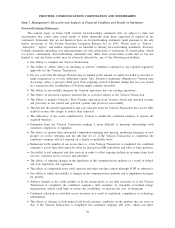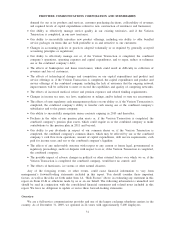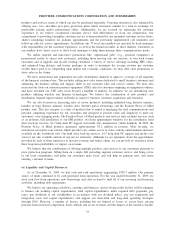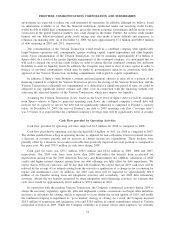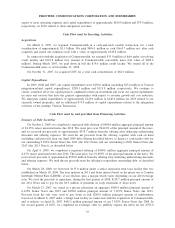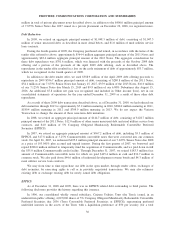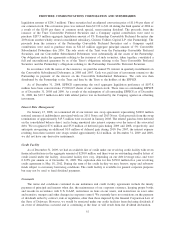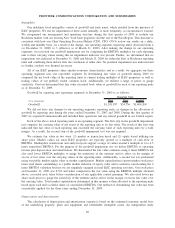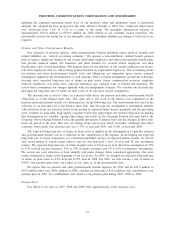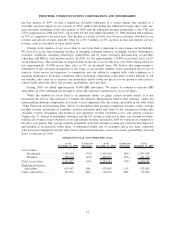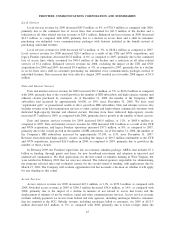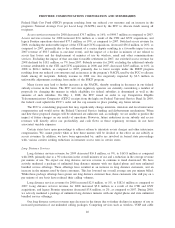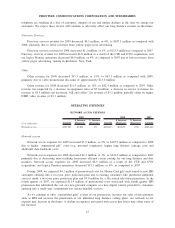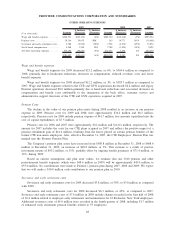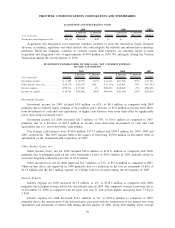Frontier Communications 2009 Annual Report Download - page 42
Download and view the complete annual report
Please find page 42 of the 2009 Frontier Communications annual report below. You can navigate through the pages in the report by either clicking on the pages listed below, or by using the keyword search tool below to find specific information within the annual report.
Intangibles
Our indefinite lived intangibles consist of goodwill and trade name, which resulted from the purchase of
ILEC properties. We test for impairment of these assets annually, or more frequently, as circumstances warrant.
We reorganized our management and operating structure during the first quarter of 2009 to include our
Rochester market with our existing New York State properties and the rest of the East Region. This structure is
consistent with how our Chief Operating Decision Makers (CEO, CFO, COO) review our results on a daily,
weekly and monthly basis. As a result of the change, our operating segments (reporting units) decreased from 4
(at December 31, 2008) to 3 (effective as of March 31, 2009). After making the change in our operating
segments, we reviewed our goodwill impairment test by comparing the EBITDA multiples for each reporting
unit to their carrying values noting that no impairment indicator was present. Further, we determined that no
impairment was indicated at December 31, 2008 and March 31, 2009 for either the East or Rochester reporting
units and combining them did not alter the conclusion at either date. No potential impairment was indicated and
no further analysis was deemed necessary.
All of our ILEC properties share similar economic characteristics and as a result, we aggregate our three
operating segments into one reportable segment. In determining fair value of goodwill during 2009 we
compared the net book value of the reporting units to current trading multiples of ILEC properties as well as
trading values of our publicly traded common stock. Additionally, we utilized a range of prices to gauge
sensitivity. Our test determined that fair value exceeded book value of goodwill for each of our reporting units
as of December 31, 2009.
Goodwill by reporting unit (operating segment) at December 31, 2009 is as follows:
($ in thousands) East West Central
Reporting Units
Goodwill ................................................ $1,201,387 $34,736 $1,406,200
We did not have any changes to our operating segments, reporting units, or changes in the allocation of
goodwill by reporting unit during the years ended December 31, 2007 and 2008. During the first quarter of
2007 we acquired Commonwealth and included their operations and any related goodwill in our Central region.
Each of the above noted reporting units is an operating segment. The first step in the goodwill impairment
test compares the carrying value of net assets of the reporting unit to its fair value. The result of this first step
indicated that fair value of each reporting unit exceeded the carrying value of such reporting units by a wide
margin. As a result, the second step of the goodwill impairment test was not required.
We estimate fair value in two ways: (1) market or transaction based and (2) equity based utilizing our
share price. Market values for rural ILEC properties are typically quoted as a multiple of cash flow or
EBITDA. Marketplace transactions and analyst reports support a range of values around a multiple of 6 to 6.5
times annualized EBITDA. For the purpose of the goodwill impairment test we define EBITDA as operating
income plus depreciation and amortization. We determined the fair value estimates using 6 times EBITDA but
also used lower EBITDA multiples to gauge the sensitivity of the estimate and its effect on the margin of
excess of fair value over the carrying values of the reporting units. Additionally, a second test was performed
using our public market equity value or market capitalization. Market capitalization (current market stock price
times total shares outstanding) is a public market indicator of equity value and is useful in corroborating the 6
times EBITDA valuation because we are singularly engaged in rural ILEC operating activities. Our stock price
on December 31, 2009 was $7.81 and when compared to the fair value using the EBITDA multiple obtained
above, exceeded such value before consideration of any applicable control premium. We also used lower per
share stock prices to gauge the sensitivity of the estimate and its effect on the margin of excess fair value over
the carrying value. Total market capitalization determined in this manner is then allocated to the reporting units
based upon each unit’s relative share of consolidated EBITDA. Our method of determining fair value has been
consistently applied for the three years ending December 31, 2009.
Depreciation and Amortization
The calculation of depreciation and amortization expense is based on the estimated economic useful lives
of the underlying property, plant and equipment and identifiable intangible assets. An independent study
40
FRONTIER COMMUNICATIONS CORPORATION AND SUBSIDIARIES


